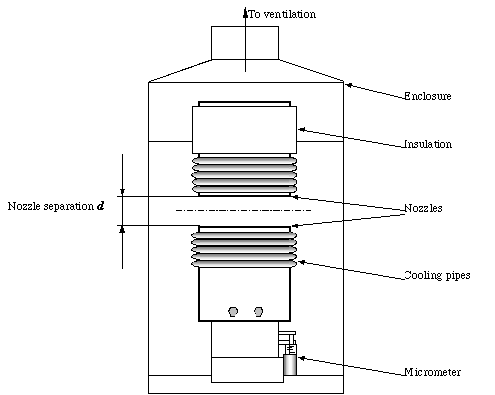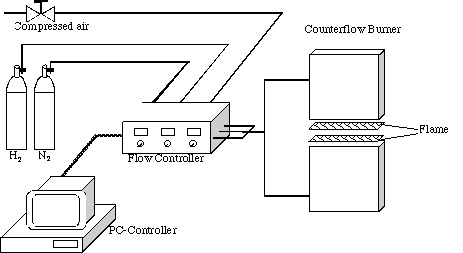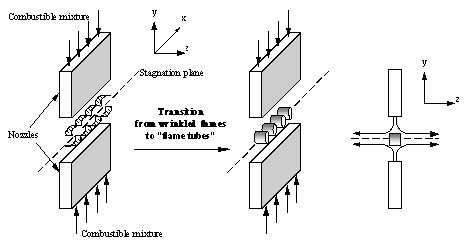
Edge flames and flame instabilities in counterflows
Flames subject to temporally and spatially uniform hydrodynamic strain are frequently used to model the local interactions of flame fronts with turbulent flow fields. The "laminar flamelet" concept presumes that each surface element of the flame front behaves as though it were a steady isolated front subject to uniform strain. The applicability of laminar flamelet models in strongly turbulent flows is questionable because in turbulent flows the strain rate (s) changes at rates comparable to s itself and the scale over which the flame front curvature and s changes is comparable to the curvature scale itself. As a step towards more realistic quantification of strain effects in turbulent premixed flames, spatially uniform premixed flames subject to temporary varying strain or curvature have been studied by numerous investigators.
We have recently studied the opposite case of steady flames subject to spatially-varying strain and in particular structures that may occur in the transition region between the extinguished and burning regions of the flame front. Spatially-varying straining flows were created using a counterflow slot-jet burner with slightly non-parallel jet exits.

Counterflow slot-burner apparatus. Nozzles are intentionally misaligned to create edge flames.

Flow system diagram
For premixed flames, when the flow configuration was premixed combustible gas vs. cold inert gas, so that only a single flame was produced, steady flame "edges" could be created where the flame would exist in the low-strain region but would be extinguished in the high-strain region. For premixed flames with the flow configuration of premixed gas vs. premixed gas, twin flames would exist in the low-strain region that converged to a corner-like tip in the high-strain region. For both configurations the local strain at the location of the stationary flame edge was somewhat lower than the strain required to extinguish flames in the same mixture subject to a spatially uniform strain. The difference was greater for the twin-flame configuration, particularly at high Lewis number (Le). For nonpremixed edge-flames the differences between uniform flames and edge-flames were found for all Le.
|
|
|
|
|
|
| Video images of edge-flames. Upper: single edge-flame, 9.0% CH4 in air, Vupper = Vlower = 63 cm/sec, wedge angle 6.8û, field of view 1.24 cm x 5.40 cm; middle: twin edge-flame, 9.0% CH4 / 31.7% O2 / 56.3% CO2 (low Le), Vupper = Vlower = 40 cm/sec, wedge angle 6.8û, field of view 2.11 cm x 9.11 cm; lower: twin edge-flame, 2.1% C3H8 / 23.0% O2 / 74.9% He (high Le), Vupper = Vlower = 30 cm/sec, wedge angle 6.8û, field of view 1.10 cm x 3.80 cm. In these views the axis of extensional strain (the short dimension of the slot jets) is in/out of the plane of the image, the long dimension of the slot jets in the horizontal direction and the flow out of the jets is in the vertical direction. | Extinction strain rate vs. fuel mole fraction for edge flames at various wedge angles and exit flow velocities. Zero wedge angle corresponds to uniformly strained flames. Upper: CH4/O2/CO2 mixtures, twin flames; middle: C3H8/O2/He mixtures; lower: single flame, CH4-air mixtures. |
Due to diffusive-thermal instabilities, cellular flames were observed at low Le and travelling-wave patterns were observed at high Le. Le effects also led to the formation of isolated "flame tubes" rather than continuous fronts at sufficiently low Le and high strain rates.

Schematic diagram of "flame tube" behavior
|
|
|
|
|
Examples of instabilities of stretched twin H2-air flames at different fuel concentrations and stretch rates. Jet spacing is 1.27 am.
All of these results are consistent with recent theoretical predictions. These results indicate that "laminar flamelet" models of turbulent combustion may not be accurate at conditions approaching those where local flame quenching occurs, except possibly for single premixed flames and low-Le twin premixed flames.
Publications
Kaiser, C., Liu, J.-B. and Ronney, P. D.,
“Diffusive-thermal Instability of Counterflow Flames at Low
Lewis Number,” 38th AIAA Aerospace Sciences Meeting, Reno,
NV,
January 11-14, 2000.
Liu, J.-B. and Ronney, P. D., "Premixed Edge-Flames in Spatially Varying Straining Flows," Combustion Science and Technology, Vol 144, pp. 21-46 (1999).
View on-line version
Download .pdf version (4.2 MB)
Download powerpoint presentation (1.8 MB)
Vedarajan, T. G., Buckmaster, J. D. and Ronney, P. D., "Two-dimensional Failure Waves and Ignition Fronts in Premixed Combustion," Twenty-Seventh International Symposium on Combustion, Combustion Institute, Pittsburgh, 1998, pp. 537-544.
Shay, M. L. and Ronney, P. D., "Nonpremixed Flames in Spatially-Varying Straining Flows," Combustion and Flame, Vol. 112, pp. 171-180 (1998).